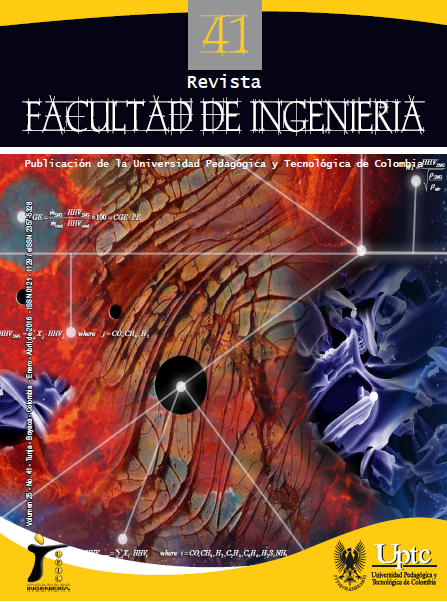Effect of colombian coal rank and its feeding technology on substitute natural gas production by entrained gasification

Abstract
The effect of coal rank (from sub-bituminous to semi-anthracite) and type of fuel feeding technology (slurry and dry) on the production of substitute natural gas (SNG) in entrained flow gasifiers is studied. Ten coals from important Colombian mines were selected. The process is modeled under thermochemical equilibrium using Aspen Plus, and its performance is evaluated in function of output parameters that include SNG heating value, Wobbe index, coal conversion efficiency, cold gas efficiency, process efficiency, global efficiency, and SNG production rate, among others. In descending order, the coal-to-SNG process improves energetically with the use of coals with: higher volatile-matter to fixed-carbon ratio, lower ash content, higher C+H/O ratio, and higher coal heating value. The overall energy efficiency of the slurry-feed technology (S-FT) to produce SNG by gasification is 17% higher than the dry-feed technology (D-FT), possibly as a consequence of the higher CH4 concentration in the syngas (around 7 vol. %) when the coal is fed as aqueous slurry. As the simulated SNG meets the natural gas (NG) quality standards in Colombia, the substitute gaseous fuel could be directly transported through pipelines. Therefore, the coal-to-SNG process is a technically feasible and unconventional alternative for NG production.Keywords
coal-SNG, substitute natural gas, coal rank, entrained flow gasification, coal feeding technology, Aspen Plus
References
- Unidad de Planeación Minero Energética, “Plan de Abastecimiento para el Suministro y Transporte de Gas Natural”, Technicalreport, UPME, Ministerio de Minas y Energía, Bogotá, 2010.
- PROURE, Programa de uso racional de la energía, “Plan de acción 2010-2015”, Technical report, Ministerio de Minas y Energía, Bogotá, 2010.
- F. A., Diaz, “The future challenges for clean coal technologies: Joining efficiency increase and pollutant emission control”, Energy, vol. 34, pp. 348-354, 2009. DOI: http://dx.doi.org/10.1016/j.energy.2008.09.012. DOI: https://doi.org/10.1016/j.energy.2008.09.012
- British Petroleum, “Statistical Review of World Energy”, Technical report, BP, London, 2011.
- J. F. Pérez, R. Barrera, and C. Salazar, Producción de gas natural sintético mediante gasificción de carbones Colombianos. Medellín, Colombia: Ed. Universidad de Antioquia, 2015.
- M. de Souza-Santos, Solid Fuels Combustion and Gasification: Modeling, Simulation, and Equipment Operation, New York, NY, USA: Marcel Dekker Inc., 2004. DOI: http://dx.doi.org/10.1201/9780203027295. DOI: https://doi.org/10.1201/9780203027295
- S. Cheng-Hsien, C. Wei-Hsin, H. Heng-Wen, S. Jieh-Yn andH. Tzu-Hsien, “Co-gasification performance of coal and petroleum coke blends in a pilot-scale pressurized entrained-flow gasifier”, Int. J. Energ. Res., vol. 36, pp. 499-508, 2012. DOI: http://dx.doi.org/10.1002/er.1821. DOI: https://doi.org/10.1002/er.1821
- J. Tomeczek and S. Gil, “The kinetics of coal chars hydrogasification”, Fuel Process. Technol., vol. 91, pp. 1564-1568, 2010. DOI: http://dx.doi.org/10.1016/j.fuproc.2010.06.003. DOI: https://doi.org/10.1016/j.fuproc.2010.06.003
- A. Karcz and S. Porada, “The influence of coal rank on formation of gaseous hydrocarbons in hydrogasification of coal”, Fuel, vol. 75, pp. 641-645, 1996. DOI: http://dx.doi.org/10.1016/0016-2361(95)00298-7. DOI: https://doi.org/10.1016/0016-2361(95)00298-7
- S. Lee, J. Kim and Y. Choi, “Hydrogasification characteristics of bituminous coals in an entrained-flow hydrogasifier”, Fuel, vol. 85, pp. 803-806, 2006. DOI: http://dx.doi.org/10.1016/j.fuel.2005.08.039. DOI: https://doi.org/10.1016/j.fuel.2005.08.039
- O. Maurstad, H. Herzog, O. Bolland and J. Beér, “Impact of coal quality and gasifier technology on IGCC performance”, Technical report, CC&ST Program,Norwegian Research Council in the KLIMATEK program, 2013.
- Y. Yun, Y. Yoo andS. Chung, “Selection of IGCC candidate coals by pilot-scale gasifier operation”, Fuel Process. Technol., vol. 88, pp. 107-116, 2007. DOI: http://dx.doi.org/10.1016/j.fuproc.2004.08.009. DOI: https://doi.org/10.1016/j.fuproc.2004.08.009
- M. Gräbner and B. Meyer, “Performance and exergy analysis of the current developments in coal gasification technology”, Fuel, vol. 116, pp. 910–920, 2014. DOI: http://dx.doi.org/10.1016/j.fuel.2013.02.045. DOI: https://doi.org/10.1016/j.fuel.2013.02.045
- C. Kunze and H. Spliethoff, “Modelling, comparison and operation experiences of entrained flow gasifier”, Energ. Convers. Manage., vol. 52, pp. 2135–2141, 2011. DOI: http://dx.doi.org/10.1016/j.enconman.2010.10.049. DOI: https://doi.org/10.1016/j.enconman.2010.10.049
- R. Barrera, C. Salazar and J. F. Pérez, “Thermochemical Equilibrium Model of Synthetic Natural Gas Production from Coal Gasification Using Aspen Plus”, Int. J. Chem. Eng., vol. 2014, Article ID 192057, 2014. DOI: http://dx.doi.org/10.1155/2014/192057. DOI: https://doi.org/10.1155/2014/192057
- R. Barrera, C. Salazar, J. F. Pérez, “Carbones colombianos: clasificación y caracterización termoquímica para aplicaciones energéticas”, Rev. ION, vol. 27, pp. 43-54, 2014.
- J. Longanbach, T. Buchanan, M. Klett and R. Schoff, “Capital and operating cost of hydrogen production from coal gasification”, Technical Report, NETL – U.S. Department of Energy, 2003.
- A. Van der Drift, B. Coda, M. Cieplik and K. Hemmes, “Entrained Flow Gasification of Biomass. Ash behaviour, feeding issues, and system analyses”, Technical Report, ECN, Netherlands, 2004.
- M. Öztürk, N. Özek and Y. E. Yüksel, “Gasification of various types of tertiary coals: A sustainability approach”, Energ. Convers. Manage., vol. 56, pp. 157-165, 2012. DOI: http://dx.doi.org/10.1016/j.enconman.2011.11.008. DOI: https://doi.org/10.1016/j.enconman.2011.11.008
- D. Harris, D. Roberts and D. Henderson, “Gasification behaviour of Australian coals at high temperature and pressure”, Fuel, vol. 85, pp. 134-142, 2006. DOI: http://dx.doi.org/10.1016/j.fuel.2005.07.022. DOI: https://doi.org/10.1016/j.fuel.2005.07.022
- S. Karellas, K. D. Panopoulos, G. Panousis, A. Rigas, J. Karl and E. Kakaras, “An evaluation of Substitute natural gas production from different coal gasification processes based on modeling”, Energy, vol. 45, pp. 183-194, 2012. DOI: http://dx.doi.org/10.1016/j.energy.2012.03.075. DOI: https://doi.org/10.1016/j.energy.2012.03.075
- Comisión de Regulación de Energía y Gas (CREG), “Calidad en tranporte de gas”, Comisión Reguladora de Energía y Gas de Colombia, Resolución 017, Ministerio de Minas y Energía, 2007.
- J. Kim, H. Choi, J. Lim, Y. Rhim, D. Chun, S. Kim, S. Lee S and J. Yoo, “Hydrogen production via steam gasification of ash free coals”, Int. J. Hydrogen Energ., vol. 38, pp. 6014-6020, 2013. DOI: http://dx.doi.org/10.1016/j.ijhydene.2012.12.058. DOI: https://doi.org/10.1016/j.ijhydene.2012.12.058
Downloads
Download data is not yet available.